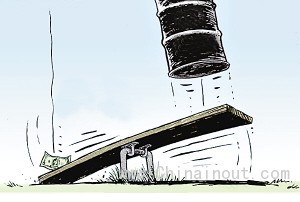有一点是肯定的:即使是当前的较低油价,也在迅速催生赢家和输家。油价大跌的输家是石油生产国、各个国家和他们的政府。如果布伦特基准原油(Brent)价格指数跌至每桶80美元,欧佩克国家近期的一万亿美元盈利就会被抹去大约2000亿美元。这不仅会影响到他们的盈利能力,让他们无法实现阿拉伯之春(Arab Spring)后增加的预算,还会影响他们的偿债能力,让他们无法在不违约的情况下偿还所负债务的利息。此外,如果油价下跌过多,美国将被迫削减用于扩大产能的资本开支,这可能会延缓美国页岩气革命的进程。
另一方面,油价大跌等价于一次超大规模量化宽松计划,它将有助于刺激磕磕绊绊的经济增长,全球经济总体会因此受益。每天,油价下跌会带来18亿美元的额外之财,这每年会产生大约6600亿美元的资金。让我们跟踪调查一下原油价格下跌对汽油价格的影响,在美国,去年每户人家用于汽油的费用约为2900美元,油价下跌带来的收益等价于每户不到600美元的税收折扣。这将对全球所有消费者产生影响——除了那些燃油开支本已极低的欧佩克国家消费者以外。
油价下跌有几个原因:部分原因要归结为市场情绪的影响,部分则是出于市场基本面的原因,还有很大一部分原因要归结为地缘政治格局的影响。自利比亚战乱令市场削减了100万桶原油产能之后,布伦特基准原油的价格平均为每桶110美元左右。尽管2011年沙特提升了原油产量,每桶110美元的布伦特原油价格还是比利比亚开战前高了大约25美元。沙特无法压低油价的主要原因是,受战乱影响的原油是轻质低硫原油,需要这类原油的炼油厂无法用密度较高、含硫量较大的原油取代它。
与此同时,自2011年开始出现了两个截然不同的倾向。第一个倾向是石油出口国国内纷纷出现治理问题。2011年2月份以前,每天只有大约40万桶原油的产能受到战乱影响。在那之后,算上受制裁的伊朗的石油产能,以及产自尼日利亚、苏丹、叙利亚及也门等受制裁国家的原油,受战乱影响的产能时常攀升至每天350万桶的规模,这导致了地缘政治上的紧张局面。
第二个倾向则是美国石油产量的巨大增长。石油生产的成本每年都在下降,盈亏平衡成本正大幅跌落至难以置信的水平,远低于每桶75美元。
对于欧佩克国家来说,其中一个困境源自两类国家之间的利益划分问题。一类是生产含硫轻油、中质原油和重质原油的海湾国家,另一类则是生产轻质原油的西方及北非国家。美国大幅增加的供应量是轻质低硫原油,这已导致全球这类原油供过于求。无论沙特和其他欧佩克国家削减多少原油产能,都无法消除轻质原油在市场中的供应过剩。
不过,还有其他基本面因素在发挥作用。全球经济十分疲弱,石油需求的增长率每天还不到1百万桶。然而,任何一个对2015年经济活动和原油需求增长的预测给出的总体供应过剩可能都会在每天1百万桶以上。如果欧佩克不削减产能,这会对油价产生更大的下行压力。此外,至少在短期内,政治风险似乎仍是油价的利空因素而非利多因素。伊朗核能协议可能会导致更多石油投向市场,而利比亚产能继续激增也会产生同样效果。
最后,价格疲软引发了一系列阴谋论。这些言论认为,沙特阿拉伯为了亚洲客户的利益压低了石油价格,而伊朗、伊拉克及其他中东石油生产国如今也在竞相压价。沙特领导人发表的声明指出,他们认为,大大低于90美元的石油价格会限制美国产量的增长。他们还认为,显而易见的是,当布伦特基准原油的价格为每桶90美元时,布伦特与美国基准原油西德克萨斯中质原油(WTI)之间的巨大差价会在2015年将WTI价格指数压低至每桶75美元以下。此外,较低的价格会为伊朗和俄罗斯带来巨大代价。这两个国家都在以沙特并不喜欢的方式向中东投入资金。
这些传闻是真的么?只有时间(或许还有11月份召开的欧佩克会议)能告诉我们这个问题的答案。如果油价继续下跌,事实可能会证明美国生产商的承受能力大大强于人们的预期。(中国进出口网)

Crude oil prices have plunged by $25, or more than 20 per cent, since mid-June, raising many questions. How low might prices go? If they rebound, at what level will they stabilise? Will Saudi Arabia and Opec move to cut output when they meet next month? At what price level might US shale oil production be affected and how severely?
One thing is certain: even the current lower prices are rapidly creating winners and losers. Losers are producers, countries and governments. If Brent falls to $80, Opec countries would lose some $200bn of their recent $1tn in earnings, affecting not only their ability to earn enough to cover the post-Arab Spring expanded budgets, but also their capacity to service debt without triggering defaults. And for the US, if prices fall much further, capital expenditures to expand production would have to be cut, potentially slowing the US shale revolution.
On the other hand, the world economy as a whole would enjoy the equivalent of a huge quantitative easing programme, helping to spur sputtering economic growth. The decline in prices would generate a $1.8bn daily windfall, some $660bn annualised. Tracking this into gasoline prices, in the US, wher last year some $2,900 per household was spent on gasoline, the windfall would amount to a tax rebate of just under $600 per household. It would affect all consumers globally save for those in Opec countries, who already pay little for fuel.
Prices have plummeted for several reasons: some of the decline is attributable to market sentiment, some to market fundamentals and, to a large measure, the geopolitical landscape. Brent crude has averaged around $110 per barrel since the Libyan disruption took 1m barrels per day off markets. Despite a Saudi production increase in 2011, $110 Brent was about $25 a barrel above traded prices just before the Libyan disruption. The main reason why Saudi Arabia could not damp prices was that the disrupted supply was light sweet crude, and refiners who needed it could not replac it with heavier, higher sulphur-content crude.
Meanwhile, two different trends have unfolded since 2011. The first has been the rise of domestic governance problems across oil exporters. Before February 2011, only some 400,000 b/d of oil was off-market because of disruption. Since then, disrupted supply has grown to more than 3.5m b/d at times, counting sanctioned Iranian oil and crude from Nigeria, Sudan, Syria and Yemen, to name a few, leading to geopolitical jitters.
The second trend is the tremendous growth of US oil output. Production is getting less costly every year and break-even costs are plummeting to much lower levels than commonly believed, certainly lower than $75 per barrel.
One of the dilemmas for Opec stems from the division of interests of the sour, medium and heavy oil producers of the Gulf and the light crude producers in west and north Africa. The US supply surge is light and sweet and has created a glut of this kind of oil globally. No matter how much crude oil Saudi or the rest of Opec cuts, it will not correct the oversupply of light crude in the market.
Yet other fundamentals are also at work. The global economy is weak and oil demand is rising at the puny rate of less than 1m b/d. Any projected increase in economic activity and demand for 2015 will probably leave an overall surplus of 1m b/d, which would weigh even more heavily on prices unless Opec cuts production. Political risk also appears more bearish than bullish, at least for the near term. An Iranian nuclear deal would mean more oil on the market, as would a continued surge in Libyan production.
Finally, price weakness has resulted in a host of conspiracy theories, based on Saudi Arabia having lowered the price of its oil for customers in Asia – price cuts now matched by Iran, Iraq and other Middle East producers. Statements by Saudi leaders indicate that they think US production growth would be hampered with oil prices much below $90, and it is already clear that with Brent at $90, a widening spread between Brent and WTI, the US benchmark, in 2015 could bring WTI below $75 a barrel. Additionally, lower prices would cost Iran and Russia dearly. Both countries are spending money in the Middle East in ways the kingdom does not like.
Are these rumours valid? only time, and perhaps the Opec meeting in November, will tell. If prices continue to fall, US producers could prove to be a more resilient bunch than is commonly thought.











